Information
LHCb-PAPER-2016-061
CERN-EP-2017-007
arXiv:1701.07873 [PDF]
(Submitted on 26 Jan 2017)
JHEP 05 (2017) 030
Inspire 1511124
Tools
Abstract
An amplitude analysis of the decay $\Lambda_b^0\to D^0 p \pi^-$ is performed in the part of the phase space containing resonances in the $D^0 p$ channel. The study is based on a data sample corresponding to an integrated luminosity of 3.0 fb$^{-1}$ of $pp$ collisions recorded by the LHCb experiment. The spectrum of excited $\Lambda_c^+$ states that decay into $D^0 p$ is studied. The masses, widths and quantum numbers of the $\Lambda_c(2880)^+$ and $\Lambda_c(2940)^+$ resonances are measured. The constraints on the spin and parity for the $\Lambda_c(2940)^+$ state are obtained for the first time. A near-threshold enhancement in the $D^0 p$ amplitude is investigated and found to be consistent with a new resonance, denoted the $\Lambda_c(2860)^+$, of spin $3/2$ and positive parity.
Figures and captions
|
Expected spectrum of the $\Lambda ^+_ c $ ground state and its orbital excitations from a study based on the nonrelativistic heavy quark - light diquark model [21], along with the observed resonances corresponding to those states [23]. |
fig1.pdf [13 KiB] HiDef png [157 KiB] Thumbnail [164 KiB] *.C file |

|
|
Definition of the angles describing the orientation of the $\Lambda ^0_ b \rightarrow D ^0 p \pi ^- $ decay in the reference frame where the $\Lambda ^0_ b $ baryon is at rest: (a) $\vartheta_p$ and $\varphi_p$, and (b) $\varphi_{D\pi}$. |
fig2a.pdf [8 KiB] HiDef png [284 KiB] Thumbnail [187 KiB] *.C file |

|
|
fig2b.pdf [6 KiB] HiDef png [243 KiB] Thumbnail [166 KiB] *.C file |
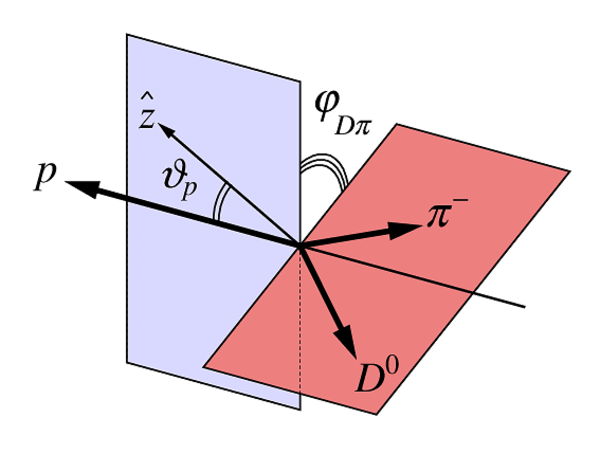
|
|
|
Distributions of $\Lambda ^0_ b \rightarrow D ^0 p \pi ^- $ candidates in data: (a) the full Dalitz plot as a function of $M^2(D^0p)$ and $M^2(p\pi^-)$, and (b) the part of the phase space including the resonances in the $D^0p$ channel (note the change in variable on the horizontal axis). The distributions are neither background-subtracted nor efficiency-corrected. The hatched areas 1--4 are described in the text. |
fig3a.pdf [607 KiB] HiDef png [665 KiB] Thumbnail [477 KiB] *.C file |

|
|
fig3b.pdf [278 KiB] HiDef png [1 MiB] Thumbnail [798 KiB] *.C file |

|
|
|
Invariant mass distribution for the $ D ^0 p \pi ^- $ candidates in the entire $ D ^0 p \pi ^- $ phase space. The blue solid line is the fit result. Signal, partially reconstructed and combinatorial background components are shown with different line styles. Vertical lines indicate the boundaries of the signal region used in the amplitude fit. |
fig4.pdf [23 KiB] HiDef png [361 KiB] Thumbnail [282 KiB] *.C file |

|
|
(a) Relative selection efficiency and (b) background density over the $\Lambda ^0_ b \rightarrow D ^0 p \pi ^- $ phase space. The normalisations are such that the average over the phase space is unity. |
fig5a.pdf [141 KiB] HiDef png [293 KiB] Thumbnail [472 KiB] *.C file |

|
|
fig5b.pdf [146 KiB] HiDef png [302 KiB] Thumbnail [390 KiB] *.C file |
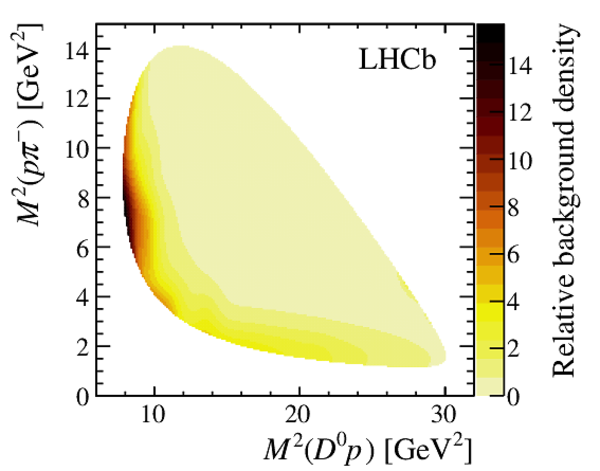
|
|
|
Fit results for the $\Lambda ^0_ b \rightarrow D ^0 p \pi ^- $ amplitude in the nonresonant region (region 1) (a) $M( D ^0 p )$ projection and (b) $M( p \pi ^- )$ projection. The points with error bars are data, the black histogram is the fit result, and coloured curves show the components of the fit model taking into account the efficiency. The dash-dotted line represents the background. Due to interference effects the total is not necessarily equal to the sum of the components. |
fig6a.pdf [12 KiB] HiDef png [335 KiB] Thumbnail [275 KiB] *.C file |

|
|
fig6b.pdf [14 KiB] HiDef png [299 KiB] Thumbnail [257 KiB] *.C file |

|
|
|
fig6c.pdf [8 KiB] HiDef png [231 KiB] Thumbnail [260 KiB] *.C file |

|
|
|
Results of the $\Lambda ^0_ b \rightarrow D ^0 p \pi ^- $ amplitude fit in the $\Lambda _{ c }(2880)^+ $ mass region with spin-parity assignment $J^P=5/2^+$ for the $\Lambda _{ c }(2880)^+$ resonance: (a) $M( D ^0 p )$ projection and (b--e) $\cos\theta_{ p }$ projections in slices of the $ D ^0 p $ invariant mass. The linear nonresonant model is used. Points with error bars are data, the black histogram is the fit result, coloured curves show the components of the fit model. The dash-dotted line represents the background. Vertical lines in (a) indicate the boundaries of the $ D ^0 p $ invariant mass slices. Due to interference effects the total is not necessarily equal to the sum of the components. |
fig7a.pdf [14 KiB] HiDef png [331 KiB] Thumbnail [288 KiB] *.C file |

|
|
fig7b.pdf [13 KiB] HiDef png [282 KiB] Thumbnail [241 KiB] *.C file |
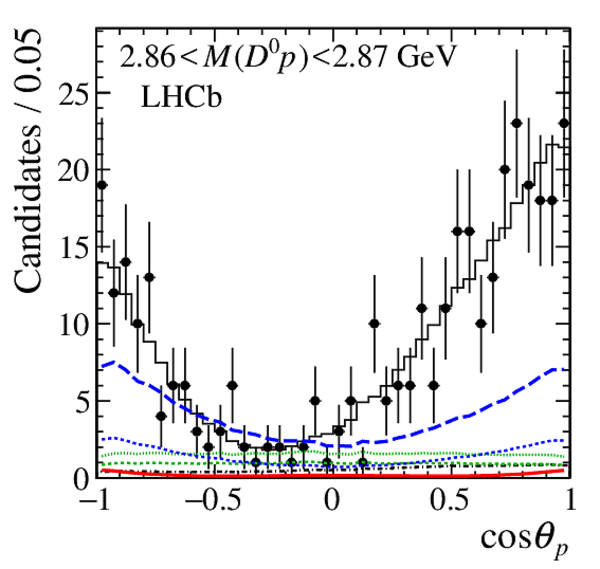
|
|
|
fig7c.pdf [13 KiB] HiDef png [281 KiB] Thumbnail [242 KiB] *.C file |

|
|
|
fig7d.pdf [14 KiB] HiDef png [312 KiB] Thumbnail [267 KiB] *.C file |
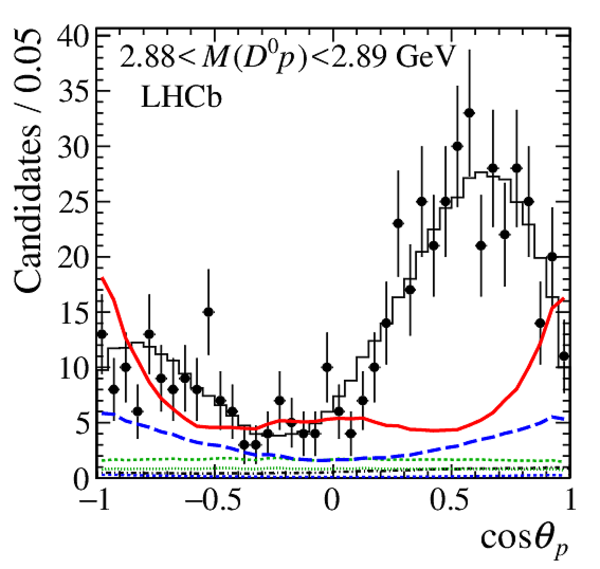
|
|
|
fig7e.pdf [13 KiB] HiDef png [284 KiB] Thumbnail [233 KiB] *.C file |

|
|
|
fig7f.pdf [8 KiB] HiDef png [116 KiB] Thumbnail [102 KiB] *.C file |

|
|
|
Argand diagrams for the four amplitude components underneath the $\Lambda _{ c }(2880)^+ $ peak in the linear nonresonant model. In each diagram, point 0 corresponds to $M( D ^0 p )=2.86$ $\mathrm{ Ge V}$ , and point 1 to $M( D ^0 p )=2.90$ $\mathrm{ Ge V}$ . |
fig8a.pdf [8 KiB] HiDef png [123 KiB] Thumbnail [128 KiB] *.C file |

|
|
fig8b.pdf [8 KiB] HiDef png [121 KiB] Thumbnail [126 KiB] *.C file |

|
|
|
fig8c.pdf [8 KiB] HiDef png [122 KiB] Thumbnail [120 KiB] *.C file |

|
|
|
fig8d.pdf [8 KiB] HiDef png [123 KiB] Thumbnail [119 KiB] *.C file |

|
|
|
$M( D ^0 p )$ projections for the fit including the $\Lambda _{ c }(2880)^+$ state and four exponential nonresonant amplitudes. |
fig9a.pdf [14 KiB] HiDef png [315 KiB] Thumbnail [275 KiB] *.C file |

|
|
fig9b.pdf [8 KiB] HiDef png [179 KiB] Thumbnail [185 KiB] *.C file |

|
|
|
Results for the fit of the $\Lambda ^0_ b \rightarrow D ^0 p \pi ^- $ Dalitz plot distribution in the near-threshold $ D ^0 p $ mass region (region 3): (a) $M( D ^0 p )$ projection, and (b--g) $\cos\theta_{ p }$ projections for slices in $ D ^0 p $ invariant mass. An exponential model is used for the nonresonant partial waves. A broad $\Lambda _{ c }(2860)^+ $ resonance and the $\Lambda _{ c }(2880)^+$ state are also present. Vertical lines in (a) indicate the boundaries of the $ D ^0 p $ invariant mass slices. Due to interference effects the total is not necessarily equal to the sum of the components. |
fig10a.pdf [13 KiB] HiDef png [337 KiB] Thumbnail [289 KiB] *.C file |

|
|
fig10b.pdf [13 KiB] HiDef png [271 KiB] Thumbnail [238 KiB] *.C file |

|
|
|
fig10c.pdf [13 KiB] HiDef png [277 KiB] Thumbnail [241 KiB] *.C file |

|
|
|
fig10d.pdf [14 KiB] HiDef png [288 KiB] Thumbnail [250 KiB] *.C file |

|
|
|
fig10e.pdf [13 KiB] HiDef png [301 KiB] Thumbnail [252 KiB] *.C file |

|
|
|
fig10f.pdf [14 KiB] HiDef png [313 KiB] Thumbnail [265 KiB] *.C file |

|
|
|
fig10g.pdf [13 KiB] HiDef png [281 KiB] Thumbnail [232 KiB] *.C file |
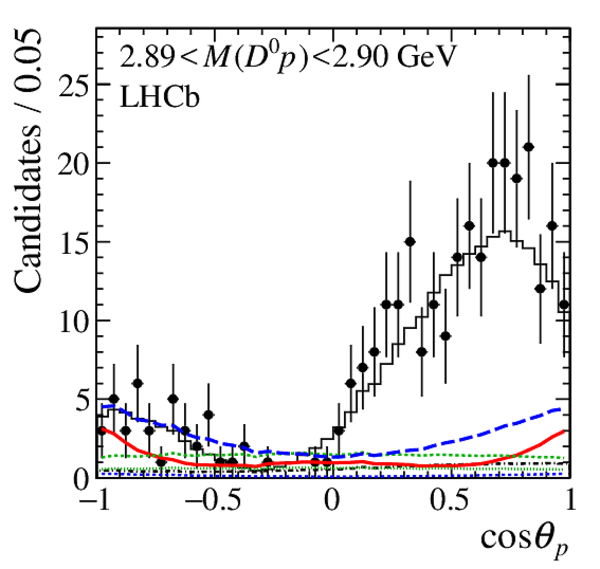
|
|
|
fig10h.pdf [8 KiB] HiDef png [114 KiB] Thumbnail [99 KiB] *.C file |

|
|
|
Argand diagrams for the complex spline components used in two fits, represented by blue lines with arrows indicating the phase motion with increasing $M( D ^0 p )$. For subfigure (a), the $J^P=3/2^+$ partial wave is modelled as a spline and the other components in the fit ($1/2^{+}$, $1/2^-$ and $3/2^-$) are described with exponential amplitudes. For comparison, results from a separate fit in which the $3/2^+$ partial wave is described with a Breit--Wigner function are superimposed: the green line represents its phase motion, and the green dots correspond to the $ D ^0 p $ masses at the spline knots. For subfigure (b), the $J^P=1/2^+$ component is modelled as a spline and $1/2^{-}$, $3/2^+$ and $3/2^-$ components as exponential amplitudes. |
fig11a.pdf [10 KiB] HiDef png [211 KiB] Thumbnail [173 KiB] *.C file |

|
|
fig11b.pdf [9 KiB] HiDef png [151 KiB] Thumbnail [127 KiB] *.C file |

|
|
|
Results of the fit including the $\Lambda _{ c }(2880)^+$ state, two exponential nonresonant amplitudes with $J^P=1/2^{\pm}$ and two real splines in $J^P=3/2^{\pm}$ partial waves. (a) Spline amplitudes for $J^P=3/2^{\pm}$ partial waves as functions of $M( D ^0 p )$. Points with the error bars are fitted values of the amplitude in the spline knots, smooth curves are the interpolated amplitude shapes. (b) The $M( D ^0 p )$ projection of the decay density and the components of the fit model. |
fig12a.pdf [11 KiB] HiDef png [190 KiB] Thumbnail [171 KiB] *.C file |
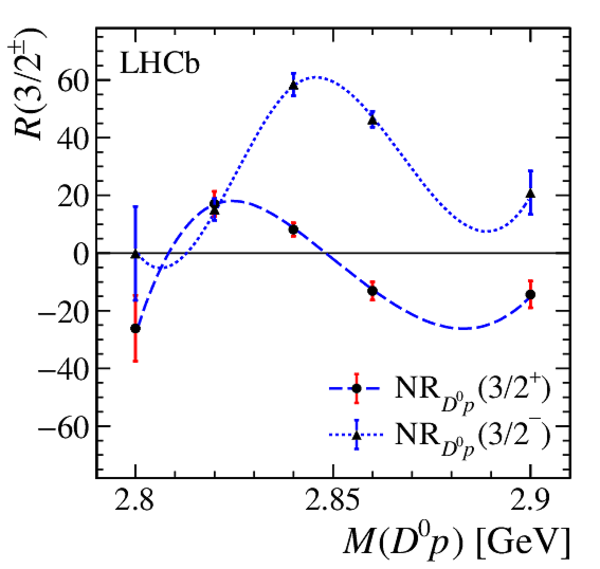
|
|
fig12b.pdf [13 KiB] HiDef png [327 KiB] Thumbnail [280 KiB] *.C file |

|
|
|
fig12c.pdf [8 KiB] HiDef png [179 KiB] Thumbnail [185 KiB] *.C file |

|
|
|
Results of the fit of the $\Lambda ^0_ b \rightarrow D ^0 p \pi ^- $ data in the $ D ^0 p $ mass region including the $\Lambda _{ c }(2880)^+ $ and $\Lambda _{ c }(2940)^+ $ resonances (region 4): (a) $m( D ^0 p )$ projection and (b--k) $\cos\theta_{ p }$ projections for slices of $ D ^0 p $ invariant mass. An exponential model is used for the nonresonant partial waves, and the $J^P=3/2^-$ hypothesis is used for the $\Lambda _{ c }(2940)^+$ state. Vertical lines in (a) indicate the boundaries of the $ D ^0 p $ invariant mass slices. Due to interference effects the total is not necessarily equal to the sum of the components. |
fig13a.pdf [14 KiB] HiDef png [349 KiB] Thumbnail [284 KiB] *.C file |

|
|
fig13b.pdf [13 KiB] HiDef png [267 KiB] Thumbnail [237 KiB] *.C file |

|
|
|
fig13c.pdf [13 KiB] HiDef png [286 KiB] Thumbnail [250 KiB] *.C file |

|
|
|
fig13d.pdf [14 KiB] HiDef png [291 KiB] Thumbnail [248 KiB] *.C file |
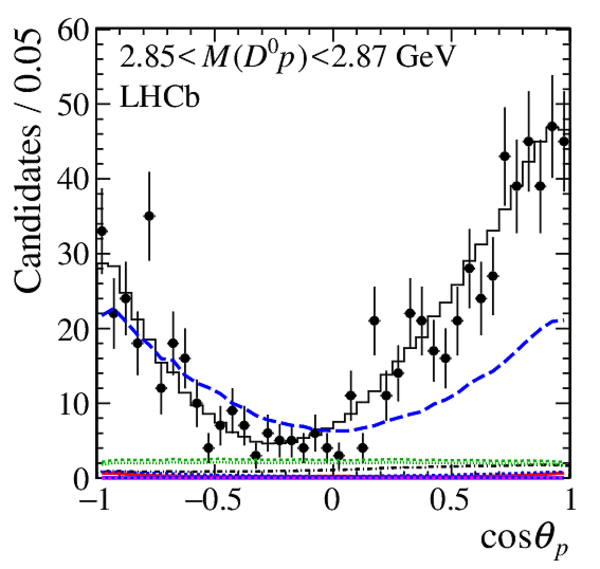
|
|
|
fig13e.pdf [13 KiB] HiDef png [303 KiB] Thumbnail [253 KiB] *.C file |

|
|
|
fig13f.pdf [14 KiB] HiDef png [309 KiB] Thumbnail [261 KiB] *.C file |

|
|
|
fig13g.pdf [13 KiB] HiDef png [304 KiB] Thumbnail [247 KiB] *.C file |
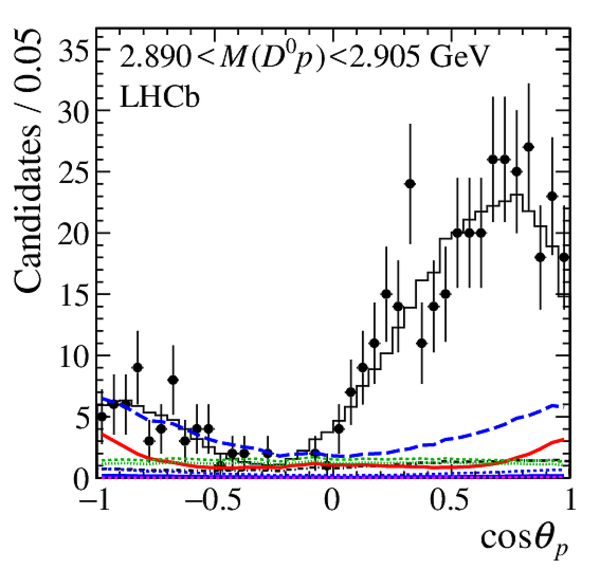
|
|
|
fig13h.pdf [13 KiB] HiDef png [289 KiB] Thumbnail [238 KiB] *.C file |
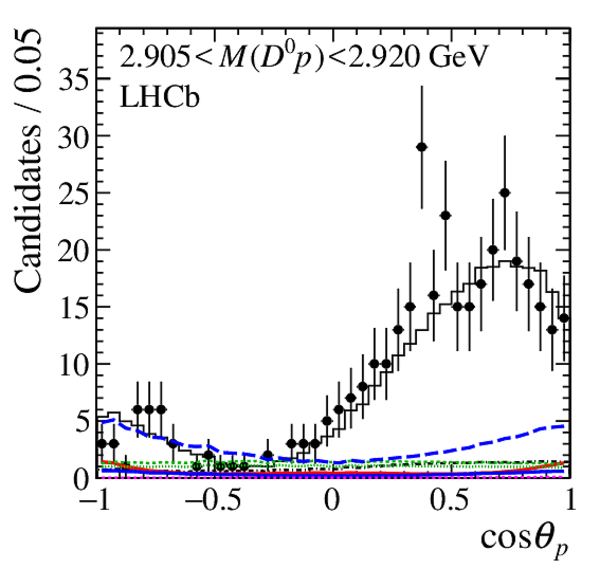
|
|
|
fig13i.pdf [14 KiB] HiDef png [307 KiB] Thumbnail [252 KiB] *.C file |

|
|
|
fig13j.pdf [14 KiB] HiDef png [308 KiB] Thumbnail [248 KiB] *.C file |

|
|
|
fig13k.pdf [14 KiB] HiDef png [313 KiB] Thumbnail [259 KiB] *.C file |
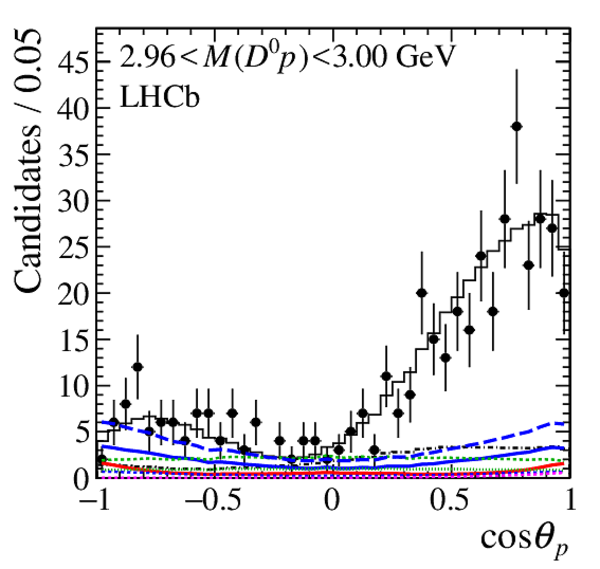
|
|
|
fig13l.pdf [9 KiB] HiDef png [142 KiB] Thumbnail [128 KiB] *.C file |
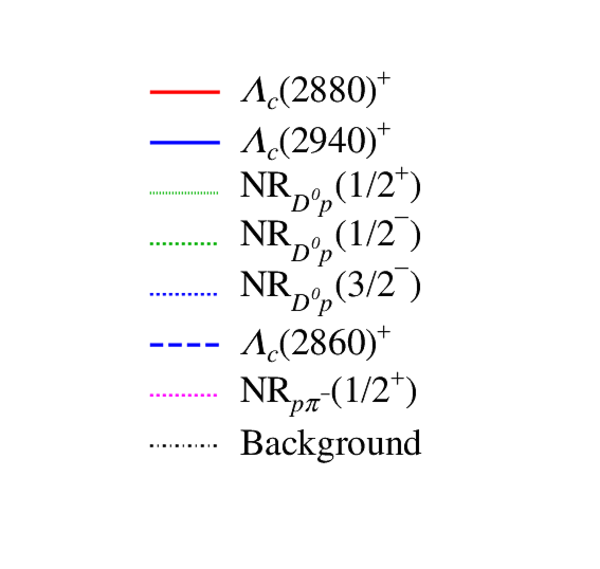
|
|
|
Animated gif made out of all figures. |
PAPER-2016-061.gif Thumbnail |

|
Tables and captions
|
Results of the fits to the $\Lambda ^0_ b \rightarrow D ^0 p \pi ^- $ mass distribution in the entire $\Lambda ^0_ b \rightarrow D ^0 p \pi ^- $ phase space and in the four phase space regions used in the amplitude fits. The signal and background yields for the full $M( D ^0 p \pi ^- )$ range, as well as for the amplitude fit region $|M( D ^0 p \pi ^- )-m(\Lambda ^0_ b )|<30\mathrm{ Me V} $ ("box"), are reported. |
Table_1.pdf [54 KiB] HiDef png [49 KiB] Thumbnail [25 KiB] tex code |

|
|
Estimated contributions from the $ p \pi ^- $ nonresonant components in different phase space regions. The signal yields from Table 1 are also included for comparison. |
Table_2.pdf [28 KiB] HiDef png [45 KiB] Thumbnail [19 KiB] tex code |

|
|
Values of the $\Delta\ln\mathcal{L}$ and fit quality for various $\Lambda _{ c }(2880)^+$ spin assignments and nonresonant amplitude models. The baseline model is shown in bold face. |
Table_3.pdf [70 KiB] HiDef png [59 KiB] Thumbnail [29 KiB] tex code |

|
|
Systematic and model uncertainties on the $\Lambda _{ c }(2880)^+$ parameters and on the value of $\Delta\ln\mathcal{L}$ between the $5/2$ and $7/2$ spin assignments. The uncertainty due to the nonresonant model includes a component associated with the helicity formalism, which for comparison is given explicitly in the table, too. |
Table_4.pdf [71 KiB] HiDef png [102 KiB] Thumbnail [49 KiB] tex code |

|
|
Quality of various fits to the near-threshold $ D ^0 p $ data. The models include nonresonant components for partial waves with $J\leq 3/2$ with or without a resonant component, whose mass is fixed to 2765 $\mathrm{ Me V}$ or allowed to vary ("Float"). "Exp" denotes an exponential nonresonant lineshape, "CSpl" a complex spline parametrisation, and "RSpl" a real spline parametrisation multiplied by a constant phase. The baseline model is shown in bold face. |
Table_5.pdf [87 KiB] HiDef png [162 KiB] Thumbnail [77 KiB] tex code |

|
|
Systematic uncertainties on the $\Lambda _{ c }(2860)^+$ parameters and on $\Delta\ln\mathcal{L}$ between the baseline $3/2^+$ and alternative spin-parity assignments. The uncertainty due to the nonresonant model includes a component associated with the helicity formalism, which for comparison is given explicitly in the table, too. |
Table_6.pdf [79 KiB] HiDef png [100 KiB] Thumbnail [45 KiB] tex code |

|
|
Correlation matrix associated to the statistical uncertainties of the fit results in the fit region 4. |
Table_7.pdf [40 KiB] HiDef png [80 KiB] Thumbnail [38 KiB] tex code |

|
|
Fit quality for various $\Lambda _{ c }(2940)^+$ spin-parity assignments. Exponential and polynomial parametrisations of the nonresonant lineshapes are considered. The baseline model is shown in bold face. |
Table_8.pdf [73 KiB] HiDef png [119 KiB] Thumbnail [57 KiB] tex code |

|
|
Systematic and model uncertainties of the $\Lambda _{ c }(2940)^+$ parameters and the resonance fit fractions. The uncertainty due to the nonresonant model includes a component associated with the helicity formalism, which for comparison is given explicitly in the table, too. |
Table_9.pdf [73 KiB] HiDef png [107 KiB] Thumbnail [47 KiB] tex code |

|
|
Systematic and model uncertainties on $\Delta\ln\mathcal{L}$ between the baseline fit with $J^P=3/2^-$ for the $\Lambda _{ c }(2940)^+$ state and other fits without a $\Lambda _{ c }(2940)^+$ contribution or with other spin-parity assignments, for the exponential nonresonant model. |
Table_10.pdf [55 KiB] HiDef png [79 KiB] Thumbnail [34 KiB] tex code |

|
|
Systematic and model uncertainties on $\Delta\ln\mathcal{L}$ between the baseline fit with $J^P=3/2^-$ for the $\Lambda _{ c }(2940)^+$ state and other fits without a $\Lambda _{ c }(2940)^+$ contribution or with other spin-parity assignments, for the polynomial nonresonant model. |
Table_11.pdf [55 KiB] HiDef png [79 KiB] Thumbnail [35 KiB] tex code |

|
|
Significances of the $J^P=3/2^-$ spin-parity assignment for $\Lambda _{ c }(2940)^+$ state with respect to the alternative models without a $\Lambda _{ c }(2940)^+$ contribution or with other spin-parity assignments. |
Table_12.pdf [46 KiB] HiDef png [95 KiB] Thumbnail [49 KiB] tex code |

|
Created on 02 May 2024.
